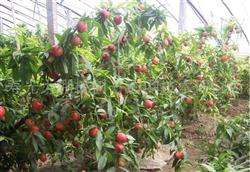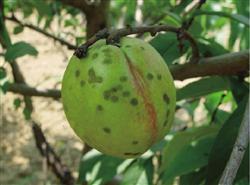Control of Diseases and insect pests in Peach

The common diseases caused by diseases and insect pests are peach leaf shrinking disease, anthracnose, brown rot, gummy disease, perforation disease; pests include red-necked longicorn beetles, aphids, beetles, floating dust, peach borer, diamondback moth, peach aphid, mulberry termites and diamondback moth, etc. Bagging is often used in southern China for prevention and control. 1. Four diseases of peach: the pathogen of peach leaf shrinking overwinters on bud scales and bark, and invades leaves and shoots before and after leaf spreading in early spring, making them deformed, withered, shedding, and can also damage fruits. The control method is to spray Baume 5-degree stone sulfur mixture when the peach bud is dilated but not yet blooming, and then spray 0.3-degree stone flow mixture after leaf expansion in serious cases, combined with manual removal of diseased leaves and burning of diseased shoots in time to reduce the source of the disease. Bacterial perforation mostly occurs in spring and summer, resulting in leaf perforation and shedding. Prevention and control method: spray 100 times Bordeaux solution in early spring sprouting (dew green period). When spraying, it should be noted that there is an interval of 7-10 days between the spraying period of Shishu mixture and the spraying period of Shishu mixture, and it is appropriate to spray 65% Dysen zinc 400-500 times after leaf expansion to avoid drug damage. Peach anthracnose is harmful to fruits and branches, which can occur from April to July, and the overcast and rainy weather after flowering is easy to cause the outbreak of the disease. It can be combined with the prevention and treatment of leaf shrinking disease and peach scab. Peach scab is mainly harmful to fruits. Spraying Baumei 0.3-0.4 degree stone sulfur mixture, or 25% carbendazim 400,500 times, or 75% topiramine 1000 times, can effectively prevent and cure the disease. 2. Peach gum disease: it is a disease caused by fungal infection and physiological causes. it mainly harms the trunk and main branches, causes gum flow and weakens the tree potential. Sticky soil, too much nitrogen fertilizer, continuous cropping, poor drainage, heavy pruning in summer, and pest wounds can all aggravate glue flow. Prevention and control methods: mainly from strengthening management, strengthening the tree potential, do a good job of tree protection. 3. Red-necked longicorn beetles: overwintering with larvae in the trunk decay path, causing damage to the trunk and root neck, weakening the tree potential or causing dead trees. Control methods: the trunk and branching parts of the adult can be whitened before spawning in late May (the whitening agent is prepared with quicklime and water according to the proportion of lvv 3-5, adding a small amount of salt can increase the adhesion, adding a small amount of stone sulfur mixture residue can improve the insect control effect) and reduce oviposition. At the same time, adults are hunted and killed artificially. Often check the tree trunk during the growing period, and hook or kill the larvae when they are found to be harmful. 4. Peach borer and pear heart borer: both damage the fruit, the latter also damage the peach shoot. Can be sprayed in the peak spawning period of 50% spiropine EC 1000 times liquid to kill larvae, spray again every 10-15 days. Bagging protection can also be carried out after spraying. 5. Peach aphid: more generations occur in a year, as peach trees sprout, eggs hatch, to harm flowers and young leaves, transfer to other hosts after June, and then return to peach trees to lay eggs before defoliation. Prevention and control methods: spraying 50% methamidophos acetate EC 500-1000 times or cypermethrin EC 1000-1300 times during the incubation period in spring can achieve better results. For peach aphids that are resistant to organophosphorus and pyrethroid pesticides, spraying 3000-4000 times of imidacloprid is especially effective. When the damage is serious, it can be sprayed again when the peach aphid moves back to the peach tree in autumn. 6. Mulberry white scale: there are 2-3 generations a year in the Yangtze River basin. The peak incubation period is in the first and middle of May, when the nymph sucks sap on the branches, weakens the tree potential, and causes the branches to die when it is serious, generally causing more damage on 2-3-year-old branches. The nymph secretes wax after the second instar and is resistant to insecticides. Control methods: in addition to spraying Baume 5-degree stone-sulfur mixture before germination combined with the prevention and control of other diseases, spray Baume 0.3-0.4 degree stone-sulfur mixture, or 1000-fold solution of 90% trichlorfon, or 1000-1500 times solution of 1000-1500 times before nymph damage. 7. Leafhoppers: adults overwinter in weeds and soil clods, and peach trees are harmful to young leaves after sprouting and feed on sap. It can be combined with the control of aphids at the beginning of exhibition and after flowering, spraying acephate and other chemicals. In addition, spraying 50% dichlorvos EC or 25% chlorpromazine 1000-1500 times during the first generation egg incubation period (about mid-late May) also had good results.
- Prev

Measures for auxiliary pollination of peach trees
Peach scab, also known as scab, is one of the common diseases of peach trees. When peach trees fall ill, black spots or even cracks appear on the diseased fruit surface, which seriously affects the commodity value. 1. Symptoms of damage: mainly damage to fruits, followed by damage to shoots and leaves. The disease of the fruit began to appear small brown spots, and later.
- Next

Correction of Nectarine physiological Disease-nitrogen deficiency
Soil nitrogen deficiency can make the leaves of the whole plant light green to yellow. Petioles and veins turn red. At this time, the growth of new shoots is hindered, the leaf area decreases, and the branches and leaves become relatively hard. If the nitrogen deficiency is too serious, the mesophyll between the large veins will appear red or reddish brown spots within 1-3 weeks. At a later stage, Xu.
Related
- Moge, come on! The staff of the peasant association in the producing area of cantaloupe were frightened when the crowd gathered.
- Causes and Solutions of low Fruit setting rate of Apple
- Symptoms and control measures of passion fruit virus disease
- Fruit growing lesson: how do apple orchards keep high yields?
- Can you build orchards in the mountains? What are the pros and cons?
- How to manage the coloring period of Crisson grape?
- This paper introduces the processing technology of two kinds of fig products.
- How much is a month for retired teachers in rural areas by 2020?
- How can strawberry planting increase sugar content? We should pay attention to management in many aspects.
- What are the cultivation techniques on how to improve the yield of golden fruit?

